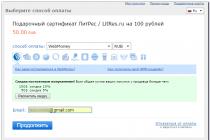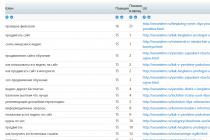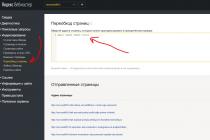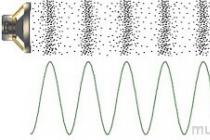Now I will show you the DIY SEO method that I used to get my website up to 5,000 unique visitors a day in just 9 months. Moreover, I promoted my site from scratch, exclusively on my own and for free.
I called this method "Impact site promotion". It differs in many ways from what is usually offered as a “recipe for SEO promotion”. But the main thing is that it works, and you can repeat it.
In this article, we will talk about the promotion of the site with the help of articles. That is, we will not buy any links. Exclusively white safe methods - they wrote an article, optimized it, brought it to the TOP, repeated this scheme 50 - 100 times. That's all promotion =)
And the very first step is choosing the right keyword for your article.
Step #1 – Select keywords per million
I hope you already know that you can’t write articles on the site “just like that”. Be sure to choose in advance a specific key query for which you will optimize your article. For example, this article is optimized for the query “do-it-yourself seo promotion”. That's why I put this phrase in the title.
Without this, search robots simply will not understand what your article is about. Although they are very smart, they are still robots.
And our task is to choose key queries that:
- Have a large number of monthly requests (otherwise you have to write 1000 articles to see any traffic);
- They have low competition (otherwise it will be almost impossible for you to break into the TOP);
- They have a good prospect of "career growth" (more on that below).
Collecting a pool of such keywords is called compiling a semantic core. And if it seems to you that it is difficult and long, it seems to you right. But it is better to spend a couple of weeks choosing 30 queries now than to spend a couple of years writing articles and not achieve anything in the end.
The ultimate keyword research tool
Let's say we want to write an article about how blogging is great and cool. We come up with such a title for the article - "Why you need to keep your blog." It would seem that the topic will certainly be of interest to a wide range of readers.
But to check, we first go to Yandex.Wordstat. This is a free tool that will immediately show you the exact popularity of a particular query. Enter the selected key in the line and click "Pick up".
As you can see in the screenshot above, this query has 0 views per month. So no one is looking for him, and no one needs him. Please note that I put the request in quotation marks. So Yandex.Wordstat shows the exact frequency. If you leave the query without quotes, it will show completely wrong numbers.
We conclude that the keyword needs to be changed. But what is the best way to formulate it? We begin to enter our main word “blog” into the Wordstat line and add interrogative words - “how”, “what”, “why”.
And here we already get a very wide field for activity. We take each keyword that we like and put it in quotes to check the exact frequency. As a result, we get:
Now that's another matter. If our article is in the TOP on request for 1500 impressions per month, then we will definitely get good traffic. But that's not the end of the story. Will we be able to break into the first places for this request? Let's now turn to another tool.
SEO Competition Checker Tool
To check the level of competition in requests, we will use a service called " Mutagen". It is paid, but every day you can do 10 free checks. Yes, and paid checks are very inexpensive - a few kopecks apiece.
The essence of this service is that it compares many different indicators of sites that are in first place in the search results for a particular query, and concludes how easy or difficult it will be for these sites to “move”.
For example, we take the same request that we found with you - “what is a blog”, enter it into the Mutagen check line and press Enter.
This query shows competition "more than 25". This is the maximum level of competition that Mutagen shows. That is, breaking into the TOP for this key will be as difficult as possible. We are not satisfied with this.
If your resource is not yet strongly promoted, then it is better to choose keywords with a competition level of 5-7 or even lower. So what do we do with this topic? Abandon the idea and write an article about something else?
Not necessarily. Now we need to try to reformulate the request so that it has a significantly reduced level of competition, and the number of requests does not fall very much. And the first thing you should try to do is to lengthen the keyword with additional words.
Now that's better. Suppose this query option has only 28 views per month. It is better to take it for the article, because it has a level of competition of only 7. If you come out on top for this key, then it is likely that Yandex will put you in the TOP for a wider one.
Many people believe that the more words in a key query, the fewer views it will have (because people are too lazy to manually enter long keywords). But as you can see, this is not always the case. We further lengthened our key, and got a competition level of only 4, and almost 200 net views.
This is the perfect key to writing an article. We stop at it and proceed to the next stage - writing an article that deserves the first place in the TOP.
Step #2 – Writing Armor Piercing Articles
The amount of money in your pocket directly depends on the amount of traffic on your site. And the amount of traffic depends on the number of articles you posted. The more articles, the more traffic. Everyone knows this, but for some reason articles are still “not written”.
And here I will give you a couple of life hacks that will help you write less and get more traffic.
Write Yourself or Hire a Copywriter?
I recommend that all owners of content sites write articles for their own resource. So you will immediately bypass the numerous competitors who hire copywriters for this business. Here's my opinion - a copywriter will never write an article well enough.
Firstly, he is not an expert in the topic on which you made your site. This will be immediately noticeable by the amount of "water" and banal advice in the articles.
Secondly, a copywriter is not the owner of the site, and he will not be killed much in order for the article to turn out to be really high-quality and quite voluminous.
And thirdly, what is called “copywriting” today is actually rewriting in 95% of cases. That is, a freelancer takes several articles on a given topic, crosses them with each other, adds some water, and that's it. Even if different text uniqueness checking services show “95-100% uniqueness” of such texts, Yandex and Google have their own verification algorithms.
Non-unique content is what search engines are now actively fighting. And if you start doing things that no one else does (that is, writing unique author's articles with really valuable content on your own), you will be immediately noticed and put in the TOP.
Should I write long articles or short ones?
One of the questions that I get asked the most is something like this: “Dmitry, why do you write such long articles for the site? Nobody reads them." In fact, they are reading. And the longer the article, the more on average a person spends on the site (within reasonable limits, of course).
I can name at least 5 reasons why you should also write long articles:
- Search robots think logically. And if they see that you have an article of 1500 words, and all other articles on this topic are 700 words, he concludes that your article contains 2 times more information on the topic. It's logical. Accordingly, he will at least give people the opportunity to "try" it.
- The longer your article is, the more words and phrases on the topic you use in it. And this gives what is called “tail traffic”. That is, 80% of your traffic will not come from the main keyword, but from many small queries that users search for 1-2 times a month.
- Even just scrolling through a long article to the end takes time. Accordingly, this greatly reduces the bounce rate - when a visitor spends less than 10-15 seconds on your site. And this is a very important indicator of the quality of the site.
- By publishing long articles on the site, you immediately show search engines that this is author's content, and not just another copywriting (more on this below).
- An article of 1.5 - 2 thousand words is very difficult to re-optimize. Even if you use the main key in the article a dozen times, against the background of the total amount of text, this will be a very easy optimization. And the search engines will have no reason to think that you are trying to deceive them.
Regarding the fourth item on this list. My articles are usually 2000 words or more. This is an average of 14 - 15 thousand characters. Today, a more or less normal copywriter on the stock exchange takes 70-80 rubles for 1000 rewriting characters. In total, to get an article for 15,000 characters, you will have to pay 1200 rubles.
For a content site, this is too much. Considering the quality of copywriting texts, you will need 300 - 600 articles to start getting meaningful traffic. These are too big expenses. Therefore, all webmasters who write articles as "copywriters" order texts for 3-4 thousand characters, no more. And so the search engines immediately distinguish them from those who write on their own.
And so you and I will not need 300-600 articles. My site reached 5,000 visitors per day with only 30 large author's articles. That is, you do not have to worry that you will have to spend your whole life, every day, for several hours to write huge articles.
It will be enough for you to write only a dozen articles, as I indicated above, and you will already have more traffic than others receive from hundreds of articles. But for this we need to help our article a little more after you wrote it.
Step #3 - Quick access to the TOP
Turnkey article optimization
After you have written an article, you need to do some light optimization (without fanaticism). To do this, take the main keyword for which the article is written, and place it in the following places:
- In the H1 header;
- In the SEO title, which is called "title";
- At the very beginning of the article (preferably in the first sentence);
- In the alt tag and in image captions;
- In the URL of your article;
- In subheading H2;
- In the middle and at the end of the article.
This will be quite enough for Yandex and Google to understand what your article is about and what key request it wants to compete for. Now it remains only to wait for the verdict of the search engines.
We speed up the release of the article in the TOP
It usually takes 2-3 months for an article to “set up” enough and take its place in the TOP of search engines. But you can also speed up this process. Then your articles can be in the first places in just 5-10 minutes after you click the "Publish" button.
To achieve the same result, here is what you need to do:
- Write and publish articles every day at a specific time. If Yandex notices that new material appears on your site every day at 12 o'clock, then soon it will start sending its special robot to your site at exactly 12 o'clock. This is the so-called "quick robot", whose task is to quickly index new and relevant materials.
- After publishing the article, go to Yandex.Webmaster and send your article for re-bypass. This is the so-called “adurilka” of Yandex:

- Post links to your new material on all social networks wherever you can: VKontakte, Facebook, Twitter, Google+ and others.
- Make a mailing list to your subscriber base with a notification about a new article (if you don’t have it yet, it’s time to start collecting)
Actually, this is where the main work on website promotion ends. Now you need to repeat this algorithm several dozen times, and your site will grow first to the “thousander”, and then to the “ten thousandth”. It would be a wish)
I hope that this article was useful to you, and now you better understand how to do SEO promotion with your own hands. Add it to your bookmarks so you don't lose it. Don't forget to download my book. There I show you the fastest way from zero to the first million on the Internet (squeezed from personal experience over 10 years =)
See you later!
Your Dmitry Novoselov
In recent years, search promotion has changed significantly: new tools and support services are constantly appearing, the work of which is aimed at improving Internet resources. Competition is growing significantly, which causes the need to look for something new and productive. Search engines, in turn, pose more difficult tasks for optimizers to get into the TOP. Now it's not enough just to buy links and place good content on the site - there are about 800 parameters that are taken into account when ranking the issue. It is impossible to keep track of all these aspects, but among them there are those fundamental ones, by working on which you will be able to implement successful SEO (Search engine optimization) on your own.
Search engine algorithms set new standards that do not allow slowing down development. We offer you effective tips on website promotion that will help you not only get into the top ten, but also constantly keep these positions.
Step 1. How to start self-promotion of the site from scratch?
The novice optimizer is faced with the task of finding out for himself the purpose of creating and promoting a resource. Most business owners do not understand what SEO optimization of an Internet site is for and how it functions. The knowledge of most entrepreneurs is limited to the fact that they simply aimlessly create Internet sites and do not know how to attract customers.
If you set yourself the task of creating and promoting a resource, then be prepared to work on it on an ongoing basis. It will not work once to invest in a business and let everything take its course, as it will be a waste of time. The Internet is teeming with such sites that are not optimized for search engines and do not carry any value for users.
Therefore, the first stage of SEO optimization in our step-by-step instructions is to determine the goals and plans that will help to implement the site:
- determine the benefits that the resource can bring to your company;
- what useful and interesting things you can give to your target audience;
- how much are you willing to invest (time, effort, money).
The more useful the resource gives users, the more valuable it is for search engines. Therefore, be prepared to create something useful and at the same time consistent with the algorithms.
After determining the main tasks that will be assigned to the resource (informing the audience, selling goods, a place to spend free time, etc.), you can proceed to the next stage.
Step 2. Internal organization of the site
You will be able to organize search promotion on your own only if the resource is technically prepared. We are talking about code, on which many things depend: from usability to page loading speed. If everything is in order with the code, and the pages are still hanging, then you should pay attention to the hosting and change it if necessary. You should have a permanent specialist who will correct the code from time to time and remove unnecessary parts of it. In the future, such manipulations will help to implement promotion in search engines on their own, since a reliable base will be prepared for this in the form of a clean, optimized code.
In the code, it is necessary to work out those elements that make the site heavy. An experienced programmer will not overload the page with unnecessary modules, and will also compress all images (the quality should remain unchanged).
When you hit the page again, you can avoid loading using caching. The page will already be stored in the cache and it will not take time to open it. This applies to those pages that contain only static elements.
Step 3. Design
The outer shell of the site forms the first impression for visitors, which is important for self-promotion in search engines. The design should be extremely clear, created according to all the rules of usability. Color and composition solutions should correspond to the theme. For example, a company that specializes in the manufacture of equipment cannot have a pink-colored website.
Visitors should have pleasant associations with your resource. All important components should be visible, such as feedback forms, call buttons, and more. Readable text will be a plus, because only because of the discomfort while reading, the user can leave your resource and switch to a more comfortable one.
If you have an online store with a huge number of products, you will need filters for convenience. This will place potential buyers and turn their routine searches into a pleasant procedure.
Now it is impossible to imagine a good site without a mobile version, since more than half of users use smartphones to search for information and order goods. Responsive design makes it possible to present users with a beautiful picture, no matter what device they use to access your resource.
Step 4. Content preparation
The next step in step-by-step website promotion is content preparation. The text content must comply with the following parameters:
- uniqueness. Find a good copywriter who can meet the uniqueness parameters and still write interesting texts. Not for every subject it is possible and necessary to write articles with 100% uniqueness, since the presence of specific vocabulary can exclude such a possibility;
- structure. The text should be divided into logical parts, each of which is titled. Enumeration lists will also help you navigate the text;
- content. The article should not only perform SEO functions, but also be interesting to users. It is necessary to reveal the topic of the article, write in a simple and understandable language, do not overload the text with key phrases, and then the article will be liked not only by the audience, but also by search bots.
The articles must contain phrases from the semantic core, which will be used to independently promote the site on the Internet. It is necessary to analyze competitors before promoting a page for any query. All keywords are divided into groups, in each of which the main phrase is highlighted. It is the main one, according to which the promotion of the resource will be carried out.
Step 5. Help in navigating the site
Another stage of our step-by-step instructions for successful SEO optimization is the creation of all conditions for a comfortable and hassle-free navigation through the resource. Creating a sitemap easily solves this problem. It is necessary not only for users to facilitate the search for the desired sections, but also for search engines that will take into account the presence of the map when ranking.
It also requires proper internal linking. Referring in one article to another published on your resource, you draw the attention of readers to other useful materials. Plus, behavioral factors improve, as users spend more time on resource pages. Linking can be successfully implemented if you create a blog on the site and share thematic materials with visitors.
Step 6. Indexing
In our instructions for SEO optimization, the matter comes to familiarizing a prepared web resource with search bots. Before opening access to the site, you need to make sure that the self-optimization of the site is performed correctly:
- the content is unique and interesting;
- pages load quickly;
- the system pages are hidden and everything functions smoothly.
You can ask someone to test the site, try to order a product, climb the pages and describe their experience of using it. This procedure will help you determine whether the resource is ready for indexing and whether users will like it.
When everything is ready, you can open the site for Yandex and Google search bots. To speed up indexing, you can add the resource to the system yourself (Yandex.Metrica, Google.Analytics), which will also help you track statistics.
Step 7. First steps in independent SEO promotion
Competitor analysis is what you need to start promoting a site after it gets into the index. The novice optimizer needs to determine how competitors are driving traffic and through which channels.
You should not abruptly apply all methods (buying links, a lot of new publications, etc.), since such surges will seem unnatural for search engines. It is necessary to do everything progressively, the main thing is to move towards attracting the target audience.
For starters, social networks will be an excellent tool, where you can directly communicate with users, answer questions in a relaxed atmosphere, inform about new products, promotions and sales. You can create a page for your company or publish advertisements in promoted publics. In any case, you will arouse the keen interest of the public.
Step 8. Link mass
When the audience has already warmed up a bit, and search engines have seen the first positive changes in behavioral factors, you can start building link mass. Here it is important to slowly and regularly add momentum, otherwise you can run into search engine filters.
In order for the purchase of links to be as efficient and safe as possible for your wallet, you need to contact a trusted exchange. SAPE specialists will show you how to promote a site for high-frequency queries and not go broke ().
Step 9. Work on a permanent basis
To stay in the top ten, you will need to constantly work on SEO-promotion of the site yourself: create new interesting content and publish it regularly, which is highly appreciated by Yandex; also promote your Internet site with the help of such third-party resources as questionnaire sites, forums, post articles on other sites. Communicating with users on blogs on behalf of the company will also bring good results, since you will always be in the public eye.
conclusions
In our step-by-step instructions, you learned how to make website promotion yourself. Work with the resource should take place on an ongoing basis, the site must be improved according to the requirements of search engines. In order for users to enjoy using your site, you should regularly warm up their interest and connect various channels to attract the target audience. In this case, you will be able to recoup the resources spent on independent SEO promotion.
Positions and attendance are the main indicators of the effectiveness of SEO promotion. For the sake of objectivity, we will consider more complex examples - requests with high competition and a commercial component. We have two topics and two pages:
Both topics can be monetized using the CPA model - selling insurance and offering a service to check the possibility of going abroad. In both topics, “there is money,” which means there is competition. You can see it without tools, just look at the issue.
Positions in Yandex:
Traffic in the last 12 months:

Positions on Google:


Being cute for Yandex and Google at the same time is possible, and moreover, the basic principles of promotion are similar. However, the situation when one search engine prevails over another is very common. Including in our examples, an example of a page in the Yandex TOP is practically not presented at the beginning of Google search results for similar queries, and vice versa, an example of a page in the Google TOP has modest indicators in Yandex. Let's analyze the tricks for each PS separately.
5 chips of free promotion under Yandex
SEO starts before the page is created. The first thing you need to know is how users search for information. To do this, use Yandex.Wordstat or see the hints in the search bar. For example, follow this link to find out exactly how people search for a product. For example, you will find out that they specify the query "health insurance", and people also care about the price and answers to various questions, for example, "do I need insurance", etc.

Use the received keywords inside the article, focusing on the density indicator. Keyword density is a measure of how often keywords are used in a text. For verification, there are special services:
The younger the site, the more careful you need to be. For projects up to a year old, it is worth staying within 3%. For older sites, the bar can be raised, but you should not go beyond 6%. For spamming keywords, you can get sanctions from the PS for trying to manipulate the issuance. In our example, the page has the following density values:

Only the lazy did not say that the article should be unique. But do not forget that the article also has headings. They must also be unique. Moreover, the site, as a rule, has two headings at once:
- Title - displayed in a tab in the browser;
- Title on the site - displayed on the page;
Use them to promote. To do this, use keywords inside the title, while putting the most frequent and important ones at the beginning of the title. Try to choose a unique text, do not copy the same title for the hundredth time.
Title and title can and should ideally be different. In this case, the title on the site should be framed in
. When forming the title of the article, do not forget about live readers, since the search robot is not the only one who will interact with the page. We have already written about how to apply knowledge in practice.
The same applies to subheadings within an article. Break information into logical blocks, separate them with meaningful subheadings.
Use all possible ways to provide content:
- Text;
- Images;
- Video;
- tables;
- Marked lists.
We mentioned this. Nothing has changed: Yandex, like people, loves various forms of presenting information. In addition to this, it is worth considering:
- Write pictures ALT + Title;
- Set the name of the picture in Latin, which includes the key;
- Tables are hard to uniqueize, but worth it;
- Try to use your keywords in bulleted lists.
Don't forget to use manual internal linking. Link to the page you want from other pages on your site. Use both anchors, for example, #buy insurance in the USA#, and non-anchor links - #following the link#, #we wrote earlier#, etc.
5 tricks of free promotion on Google
Google loves long reads. Large articles that reveal the topic from all sides. However, Google does not like volume for the sake of volume. There is no algorithm for how many characters should be in an "ideal" article. Alternatively, you can peep the volume from competitors who are already in 1-3 positions for the query you need. Ultimately, it is important to find a balance between volume and usefulness, you must always pursue the main goal - the article should completely close the user's question.
The article should give the user an answer to all questions so completely that the reader no longer googles. If you are in the TOP or near it, and traffic goes to you, but the reader quickly closes the page, returns to the search engine and searches for the same question again, then it is a matter of time before Google removes your page from the TOP.
When a user selects a result on a Google search page and clicks on a link, they are not immediately taken to the site. First, the search engine redirects the user to a special tracking page and only then to the site. This happens quickly and automatically. Artificially boosting behavioral factors in the long run will not work, so focus on the quality of your content.
Keep the material updated. Google will notice any change in tact, and this will be another plus for you. If your site system allows, then not only refresh the page, but also change the publication date or add an update date. It makes no sense to do this without updating the content, updating the information is more important than changing the date.
An example of a page about traveling abroad: last year the amount of debt changed from 10,000 rubles to 30,000, after which a person may become restricted to travel abroad. Many sites remained with the old numbers and gradually their positions sank. By quickly replacing figures and facts in the article, you can bypass even more eminent competitors.
Try to keep the pages up to date. To automate, set up Google Alerts on topics of interest to you and get a weekly summary of your queries.
Make sure your articles are commented on. If you don’t have an audience yet, then do it yourself (from different profiles). Alternatively, you can order comments on your site on special exchanges. This is especially important to do the first time after the release of the material. It is important to keep the comments as realistic as possible, use keywords internally and simulate live communication.
Information that search engines have ceased to take into account meta tags slips with enviable regularity. Here, webmasters and SEOs are divided into two camps - some do not believe in their benefit, others continue to fill in the Description / Keywords fields on each page. Google announced 9 years ago that the keywords meta tag does not affect search results in any way. Sosnovsky's experiment proved in practice that filling in these fields can be neglected in the case of Yandex. Therefore, this can indeed be neglected, but in 2019 it cannot be neglected:
- The presence of a mobile version of the site;
- Page loading speed;
- Full translation of the template;
- Removing unnecessary links or closing them in nofollow;
How to independently and for free promote the site
The famous phrase of Bill Gates - "Content is king", said back in 1996, has not lost its relevance in 2019. Content is still important for successful SEO. You must provide the reader with useful information that fully reveals the topic and answers the user's question.
If you have a limited budget or none at all, then focus on content. Take note of our material,. The ability to buy links will improve your position. Both sites in the example also get backlinks in different ways, but in this case, the links are not the basis for promotion.
In 2019, you should take a closer look at LSI copywriting. This method replaced the classic SEO copywriting, where only keywords were used and their density was constantly measured. LSI copywriting is built on the content and meaning of the text, where, in addition to keywords, various synonyms, word forms and other words and phrases that are close and characteristic of the topic in their context are used.
For example, going back to the US insurance example, the words "medicine", "illness", "pills", etc. just are the techniques of LSI-copywriting.
Share your observations and best practices on free SEO project promotion in the comments.
You have decided that without search promotion, further development of the project is impossible. We found a specialist, gave him access. After a while, you get a weighty list of recommendations for implementation - at the level of the site structure, texts, and even the most sacred - design.
How to understand that all this is really necessary, and what exactly does an SEO specialist do to optimize your resource?
Regardless of whether you are engaged in site promotion in Russia, Ukraine or the USA, and, accordingly, focus on Yandex or Google, the promotion process as a whole does not change. Of course, as in other areas, there are no clear restrictions and much depends on the specifics. But still there are about a dozen mandatory stages of work.
Do you want to know about the stages of promotion specifically for your project? We will advise:
1. Analysis of the site, topics and competitors
- Internet shops.
- Websites for services and products.
- News sites.
- Boards of announcements.
- Corporate sites.
- Forums.
When an SEO specialist gets all access to project analytics and webmaster panels(or adds a site there on his own), he begins to analyze the goods and services of the project, and also gives an overall assessment of the site in order to understand what work needs to be done first.
It is at this stage that a project promotion strategy and a detailed work plan are formed.
What exactly does a specialist do?
- It analyzes the overall visibility of the site not only for high-frequency queries, but also for medium- and low-frequency queries.
- Conducts an analysis of competitors, market leaders, in order to understand what to focus on in this topic, what is better on competitors' websites.
- Analyzes the structure of leading sites in a niche, their link profile.
- Marks requests for which landing pages need to be created and optimized on the client's website.
- Conducts both regular analytics based on search results and system analytics, for example, using Serpstat.
Why is all this necessary? An SEO specialist determines whether it is necessary to immediately carry out global changes on the site. For example, change the CMS (content management system), adapt the site for mobile devices, change protocol from http to https etc.
A competent specialist notifies the need for global changes in advance in order to clarify with the programmers how possible, for example, the revision of the current version of the CMS.
It also allows you to clarify the entire budget for website promotion - the cost of content, links, other expenses.
It is better to make global changes in advance, otherwise, after 3-4 months of work on implementing an SEO audit, you will find yourself at a dead end - you will encounter the fact that it is technically impossible to optimize filters, add new tags or categories.
2. Formation of the primary core of search queries
For which projects this stage is relevant:
- Internet shops.
- Websites for services and products.
- News sites.
- Business card sites (not one-page sites).
- Boards of announcements.
- Corporate sites.
- Forums.
Now you have in your hands a promotion strategy, a work plan, a preliminary analysis of the site and sites of market leaders. At a new stage, an SEO specialist, using Serpstat, Wordstat and other tools for collecting search queries, collects, clusters into groups, breaks through the frequency semantic core.
It will be useful for:
- formation of the site structure;
- compiling templates for generating and forming meta tags manually (Title, Description, Keywords), headings H1, H2;
- writing texts on landing pages;
- creating a competent linking;
- external site optimization;
- site visibility analysis.
The semantic core can consist of both several hundred search queries (for small business card sites) and several hundred thousand (for online stores).
The process of compiling the core is long and, depending on the size of the site, can take several months. That is why it is divided into sections and categories so as not to slow down progress and expand the semantic core in parallel with other works.
3. Formation of a broad site structure
For which projects this stage is relevant:
- Internet shops.
- Sites of services and products, except for some projects with a narrow focus.
- News sites.
- Business card sites (not one-page sites).
- Boards of announcements.
- Corporate sites.
- Forums.
Search engines are constantly improving their algorithms and show the most relevant pages for user queries. If you type “laptops with backlit keyboards” into the search engine, you will see the pages most relevant to these queries in the first places.

If you want to see your project in these positions, you cannot do without the formation of a broad site structure. For each group of search queries, you need to create and optimize your landing page.
At the same time, it is important to remember that it is better to optimize specific product cards for super-low-frequency queries, since they will only interfere with the promotion of important pages, taking away some of their internal static weight.
A request that was entered no more than 5 times a month is considered super-low-frequency.
Category pages are created for high-frequency queries, and static filter/filter intersection pages are created for medium and low-frequency queries.

Where do you get ideas for creating new landing pages?
- Issuance analysis.
- Analysis of competitors.
- Internal site search.
- Analysis of the product range / range of services.
For large stores with distribution centers in different cities, as well as bulletin boards, marketplaces, companies with branches, the number of landing pages in the structure is multiplied by the number of cities. At the same time, it is important that the content of such pages is unique.
This is a long process, and in large projects, new filter pages for specific categories are created even two years after the start of promotion of the site. But still, the bulk of the work to expand the structure of landing pages should be carried out much earlier - in order to quickly get the desired effect.
4. Formation of a task for internal optimization
For which projects this stage is relevant:
- Internet shops.
- Websites for services and products.
- News sites.
- Business card sites (not one-page sites).
- Boards of announcements.
- Corporate sites.
- Forums.
The specialist corrects errors in the internal optimization of the site, works with landing pages for groups of queries, removes duplicate pages. To do this, a technical SEO audit of the site is carried out, on the basis of which a task for internal optimization is formed.
The following items must be completed (in order of importance):
- Setting up automatic generation of Title, Description and H1 headers based on templates for categories, products, filters, filter intersections, pages created for geoqueries, and the like.
- Formation of page addresses on the site (bringing them to a human-readable form).
- Filter optimization: creating rules for generating URLs for filters and their intersections, meta tags, visibility of links to filters).
- Increasing the speed of server response, loading site pages.
- Removing duplicates with permanent redirects, canonical URLs, noindex follow.
- Create an XML sitemap.
- Multilingual setup (if language versions are available).
- Optimization of pagination pages.
- Optimization of server response code and page headers.
- Setting up micro-markup of reviews, information on the pages of product cards.
5. Organization of internal linking
For which projects this stage is relevant:
- Internet shops.
- Websites for services and products.
- News sites.
- Boards of announcements.
- Corporate sites.
- Forums.
Often the reason for poor site ranking is the problem with filling promoted pages with static weight. What are we talking about?
It is important not only to create landing pages, but also to organize internal linking so that users and the search robot can easily get to other pages. Otherwise, they may not appear in the search engine index.
This problem usually occurs with pages of optimized filters - the user can get to such pages by selecting a filter, but the search robot does not see it.

Also, at the site promotion stage, an SEO specialist builds a linking of menu categories using developed scripts, where he adds previously collected and clustered queries, transfers static weight from pages with low competition (for example, from product cards, filter intersections) to pages of a higher level of nesting.
6. Content optimization
For which projects this stage is relevant:
- Internet shops.
- Websites for services and products.
- News sites.
- Business card sites (not one-page sites).
- Boards of announcements.
- Corporate sites.
The optimizer manually generates unique meta tags (Title, Description, Keywords) and H1 headers based on the "long tail" of search queries for those pages where it is needed. Also, for the promoted pages of the site, texts are formed that include previously collected key queries, of course, taking into account the current requirements of search engines.
Texts affect both the ranking of pages for high-frequency queries and the display for long-tail queries.
7. Working with the crawl budget
For which projects this stage is relevant:
- Internet shops.
- Sites of services and products, where it is possible to filter the search results, sort them.
- Boards of announcements.
The crawl budget of a search robot is the number of pages that it can crawl at one time on the site.
Often site owners, after reading 1-2 articles on site promotion using filter and tag optimization, create hundreds of pages of useless filters for which there are no requests or there are very few of them. Moreover, pages of intersections of two filters from one block (for example, two brands), intersections of four or more filters are not closed for the robot. They do not hide pages of various sortings: by price, rating, number of products per page. These are all gross errors.
As a result, the search robot can index only a part of the filter pages and leave the site. Even if you do everything else competently, this is what will cause the pages to not be included in the index. Moreover, the static weight of category pages will be greatly reduced.
Great case for working with filters: “How to save a project and increase organic traffic by 109% in 6 months”.
It is recommended to work with the crawling budget only for specialists with experience. Specialists will competently close "junk pages" for indexing, created only for the convenience of users, leave only the necessary filters, prohibit robots from bypassing "junk pages" and close links to them.
8. Improving site usability
For which projects this stage is relevant:
- Internet shops.
- Websites for services and products.
- News sites.
- Business card sites (not one-page sites).
- Boards of announcements.
- Corporate sites.
- Forums.
Do search engine algorithms take into account behavioral factors - how the user interacts with the site? Yes, take into account.
SEO specialists work on:
- non-return of the user to the search results;
- decrease in the bounce rate;
- increasing the duration of stay on the page.
Adapting a site for mobile devices will significantly increase the visibility of the site in mobile search results, and conversions from mobile devices will also increase. Simplifying navigation reduces the bounce rate. A well-designed “About us” page will increase the trust of visitors and search engines.
9. External site optimization
For whom is this relevant? For all types of sites in highly competitive topics.
Yes, in a number of topics with low competition, you can do without building up an external link mass, but in general, external optimization is necessary. The more high-quality thematic sites link to you, the more authoritative you become in the eyes of search engines.
There are many parameters by which you need to build a link profile and select donors. SEO specialists can use permalink exchanges, add natural links from forums, Q/A services, and directly post through webmasters of sites that do not sell links.
10. Increase conversion from visitors to customers
For which projects this stage is relevant:
- Internet shops.
- Websites for services and products.
- News sites.
- Business card sites (not one-page sites).
- Boards of announcements.
- Corporate sites.
Conversions are not necessarily sales. This can be either an order for services or a subscription to a newsletter.
In fact, this is a complex stage that requires design knowledge, usability, email marketing, and even quality content creation skills.
What does the specialist do in the first place?
- Fixes order forms.
- Adds ways to communicate with managers through the site.
- Changes the colors of page elements.
- Works with reviews.
- Sets up triggered personalized mailings.
And this is only a hundredth of the improvements that increase the conversion of the site.
11. Staged page optimization
For which projects this stage is relevant:
- Internet shops.
- Websites for services and products.
- News sites.
- Boards of announcements.
- Corporate sites.
- Forums.
Based on the ranking of pages by queries and traffic analysis by categories, SEO specialists constantly work with the site structure, expand it, make changes to texts, meta tags, internal linking, external link mass of pages. This is a long process.
Everything is complicated by the constant updating of search engine algorithms, and therefore it is often necessary to make changes to the website promotion strategy and constantly improve it for users and search engines.
conclusions
It is conditionally possible to distinguish 11 main stages of the work of an SEO specialist:
- Analysis of the client's website, topics and competitors. Formation of strategy and work plan. Relevant for all types of sites.
- Collection and clustering of semantics, formation of the primary core of search queries. Relevant for all types of sites.
- Creation of a broad site structure. Irrelevant for specific products and niche services that solve specific goals.
- Conducting an audit, the formation of a task for the technical optimization of the site. Relevant for all types of sites.
- Internal linking, increasing the internal weight of important pages for promotion. Relevant for everyone, except for small business card sites and specific products.
- Content optimization. Relevant for all types of sites.
- Working with crawl budget. Relevant for online stores, bulletin boards, services where it is possible to filter the results and sort by various parameters.
- Website usability improvement. Relevant for all types of sites.
- External optimization, working with a link profile. Not relevant for topics with low competition.
- Increasing the conversion rate from visitors to customers. Relevant for all types of sites, except forums.
- Step-by-step optimization of pages by sections, categories, implementation of improvements based on data analysis. May be irrelevant for small business card sites.
Almost all stages are not applicable to one-page sites.
Of course, there are many nuances that are beyond the scope of this review. For example, the correct transfer of the site



Don't want to waste time reading?
Just fill out the brief for the service you are interested in! Order website promotion Order website development
Most of our clients are satisfied with the result and recommend us to others, but there are also those who are not satisfied and believe that SEO is a myth. And we will not contradict them and make excuses. Website promotion in search engines I am index And G o o g l e more like Alice in Wonderland than a physics reference book. Not everyone is able to withstand all the difficulties of progress and reach the end of the chessboard.
We regret that they did not have the patience to bring the matter to a quality result and that they are no longer our customers.
And it happened because:
To be honest, we are “white envy” of those whose business can work without SEO website promotion. Our clients cannot, like 90% of all business…
We can't break the promise we made to our clients and anyone who needs quality promotion - we do the best SEO in the country.
We promised and we are doing it.
We keep our word. Your OLITs.
Website promotion up to 1000 requests
The cost is from 80 000 rubles.
Website promotion up to 3000 requests
Cost from 110,000 rubles.
Website promotion for all subject requests
Cost from 200,000 rubles.
IMPORTANT
"as a rule, the budget for search marketing is an individual matter and the cost may vary
from base tariffs both up and down."
- Contextual advertising - to improve recognition rates and increase targeted traffic
- Targeted advertising in social media - for greater audience coverage
- Properly configured e-mail marketing - for quick notification of customers
- Work with the brand reputation - working off the negativity on the network by responsible persons, communicating and solving problems with customers
We hope that this article will help you decide on the choice of a company to promote your business on the Internet!
Why do you need to order website promotion from us?
website promotion from OLiT is:
- Only white, author's methods of promotion - confidence in the future!
- We are not trying to "cheat" search engine algorithms, we know how to improve your site!
- We show results faster than others!
- Teaching the client the fundamentals of search engine optimization!
- We use our own technologies and services to automate and achieve results!
- Free implementation of recommendations by our programmers!
- Using the synergy of Internet marketing (SEO + SMM + SERP + classifieds + geolocation services + directories + app stores)!














